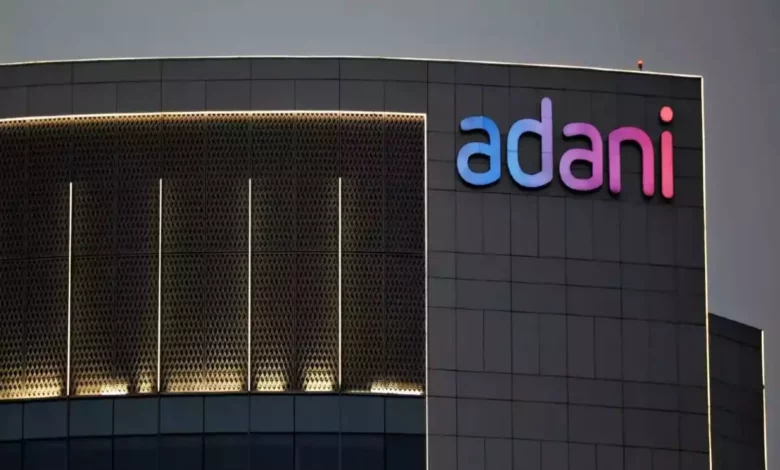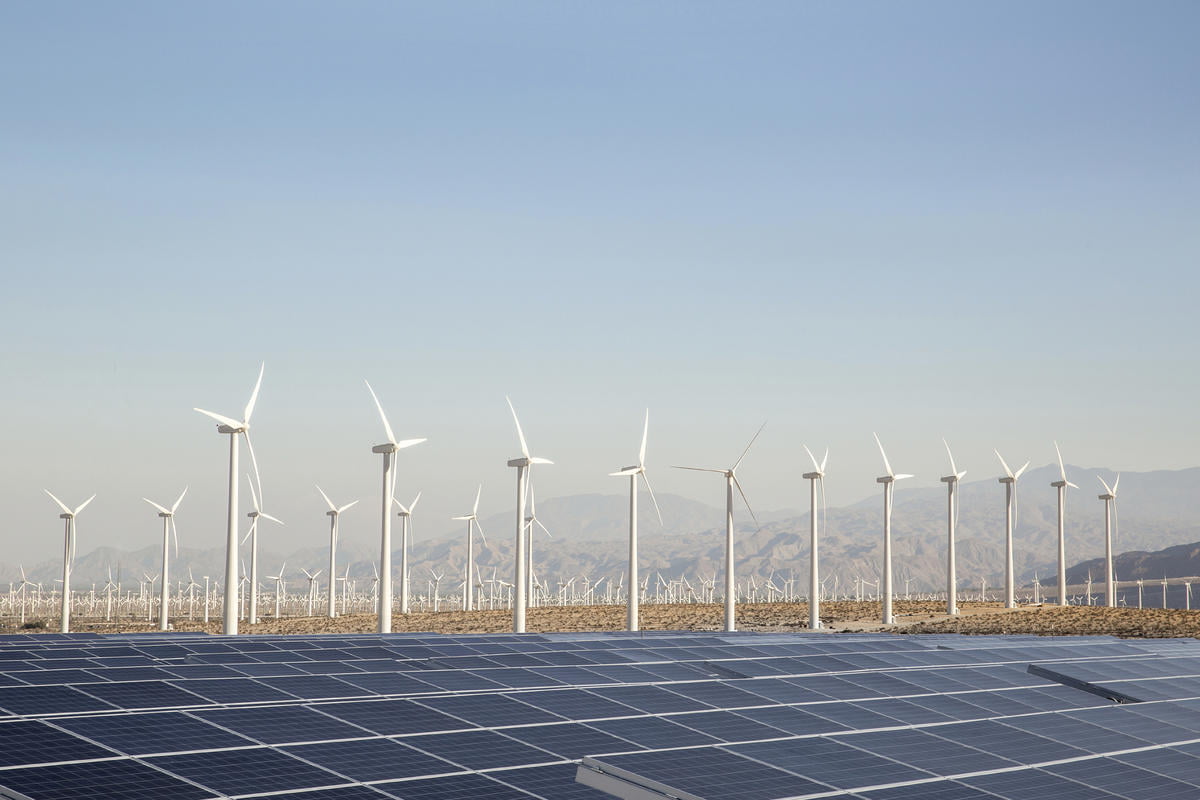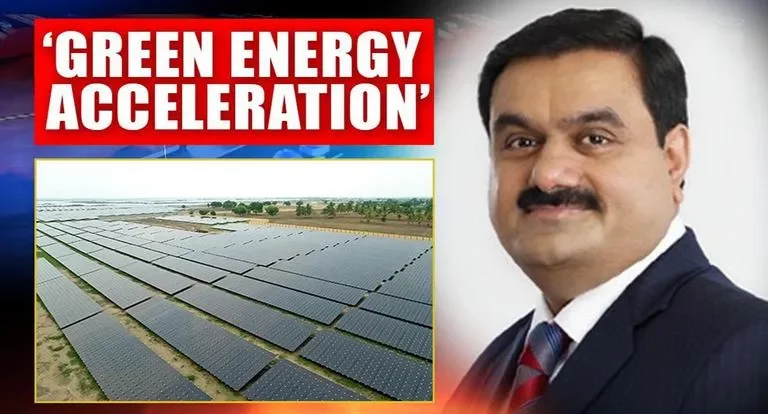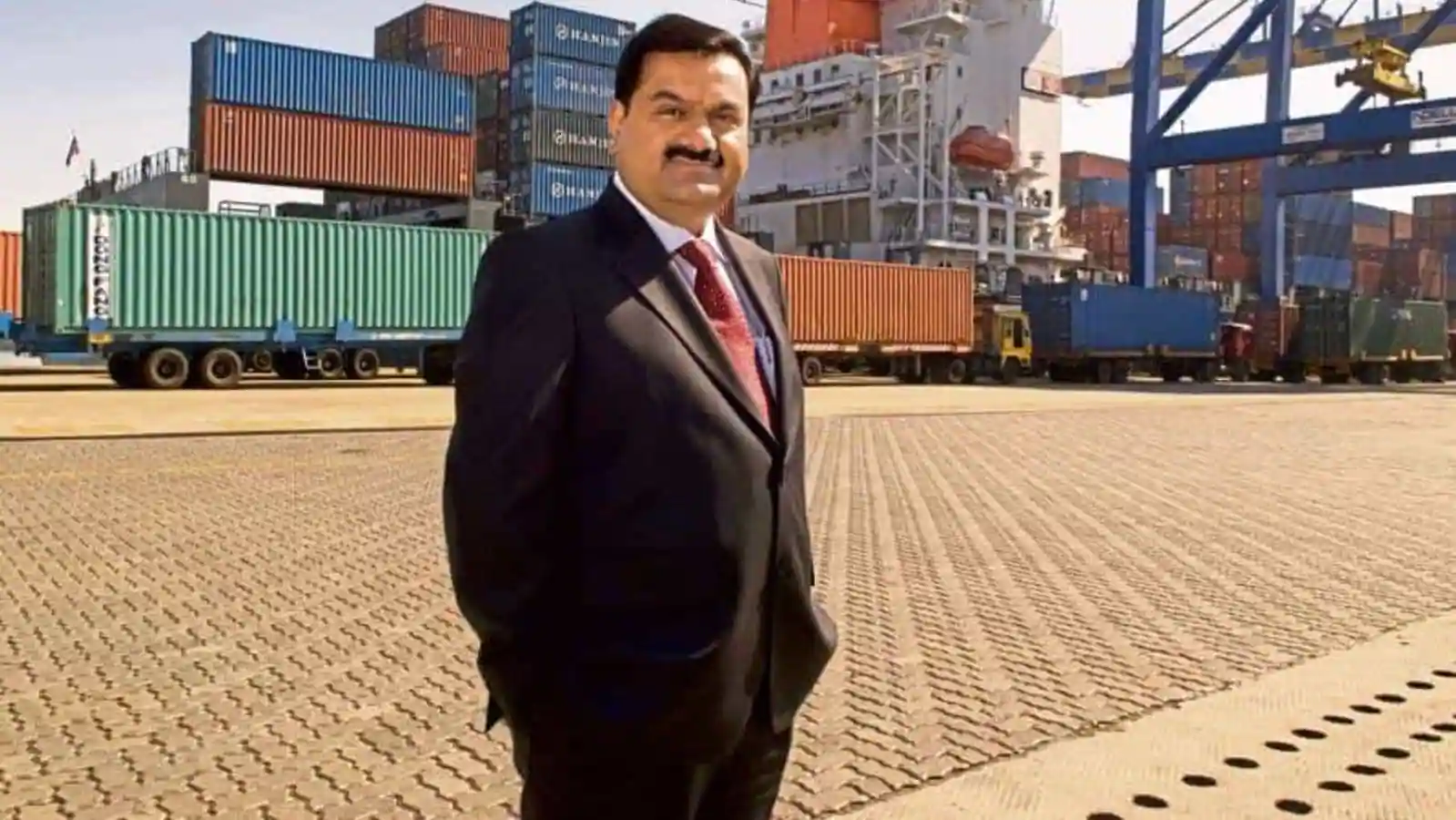Adani Green Becomes Tenth Most Valued Firm With Market Cap Of Rs 4.22 Lakh Crore

Adani Green Becomes Tenth Most Valued Firm With Market Cap Of Rs 4.22 Lakh Crore
Adani Green Energy today has a market capitalisation of Rs 4.22 trillion, surpassing Bharti Airtel, which has a market capitalisation of Rs 4.16 trillion.
On Monday, Adani Green Energy’s stock price soared 16.3% to a record high of Rs 2,701.6 on the BSE, ranking its top-10 most valuable businesses in market capitalisation (m-cap).
After UAE’s International Holding Company decided to invest Rs 3,850 crore in Adani Green Energy through a preferential issuance, the stock has risen about 25% in the last two trading days.
The firm’s board of directors authorised a preferential offer of up to 20.02 million equity shares for cash to IHC Capital Holding.
Adani Green Energy offers one of the world’s largest renewables portfolios, catering to investment-grade counterparties, with 20.4 gigawatts of locked-in growth across operational, under-construction, awarded, and acquired assets. Solar and wind farm projects are developed, built, owned, operated, and maintained by the company. Solar Energy Corporation of India, National Thermal Power Corporation, and many state discoms are the company’s main customers.
Adani Green has established a goal of 45 GW of renewable energy capacity by 2030, which is 10% of the country’s 450 GW renewable energy objective.
Last month, Adani Green raised $288 million in construction finance for its under-construction renewable asset portfolio through definitive agreements inked with a consortium of prominent international lenders, bringing its total construction financing framework to $1.64 billion.
The facility will first be used to fund a 450 megawatt solar and wind renewable energy portfolio being built in Rajasthan, India. The company closed a $1.35 billion construction revolver facility in March 2021, making it one of Asia’s largest project financing agreements.

About Adani Green
Adani Green Energy Limited (AGEL), located in Ahmedabad, Gujarat, is an Indian renewable energy firm. Adani Group, an Indian company, owns it. The company manages the Kamuthi Solar Power Project, which is one of the world’s largest solar photovoltaic facilities.
History
Adani Green Energy Limited was established on January 23, 2015, under the Companies Act 2013.
AGEL and Inox Wind collaborated to build a 20 MW wind power facility in Lahori, Madhya Pradesh, during the company’s early days. AGEL also purchased Inox Wind’s 50 MW wind power plant in Kutch’s Dayapar hamlet. The latter designed the project after it won a capacity bid for wind power plants connected to the National Grid from the Solar Energy Corporation of India.
The Government of Rajasthan and Adani Renewable Energy Park Limited, a subsidiary of AGEL, signed a joint venture agreement in 2015–2016.
In 2017, the business acquired complete control of Adani Enterprises’ entire solar energy portfolio and went public on the NSE and the BSE.
Operations
Currently, the firm manages 5,290 MW of wind and solar power plants in 11 Indian states, including Uttar Pradesh, Rajasthan, Punjab, Maharashtra, Gujarat, and Madhya Pradesh, Chhattisgarh, Andhra Pradesh, Karnataka, Tamil Nadu, and Telangana, with 46 operating projects. AGEL now has a 5.29 GW project portfolio and a 2.32 GW operational capacity.
AGEL has one joint venture and 39 subsidiaries as of March 31, 2019.
AGEL was awarded the world’s largest solar bid, valued at $6 billion, by the Solar Energy Corporation of India in May 2020. (SECI). AGEL will construct an 8000 MW photovoltaic power plant as part of the offer.
AGEL revealed its decision to purchase SB Energy Holdings Limited, which is financed by SoftBank Group Corp, for $3.5 billion in May 2021.
Green bonds
AGEL is the first Indian business to offer international investors investment-grade US dollar green bonds worth US$362.5 million in late 2019. On October 15, 2019, the bonds were listed on the Singapore Exchange Securities Trading Limited (SGX- ST), and they will mature on the same date in 2039.
Acquisitions
Kodangal Solar Parks Private Limited became a joint venture of AGEL in March 2018, when AGEL acquired 49 per cent of the company’s equity shares. AGEL also bought the remaining 51% equity stake in 2019.
AGEL paid US$185 million (about 1,300 crores) for Essel Group’s 205MW solar power portfolio in Punjab, Karnataka, and Uttar Pradesh in mid-2019. AGEL has also agreed to purchase the former’s remaining 480MW solar energy portfolio, which is currently being built.
Total S.A., a French energy corporation, signed a formal deal with AGEL in early 2020 to invest US$510 million to purchase a 20% share in the latter.

Why is renewable energy essential?
Renewable energy is beneficial to both the environment and people, but what precisely is it? Learn more about green energy, the world’s fastest-growing source of energy, and how we can use it to help the climate, the environment, the economy, and social cohesion, from solar to wind.
What is renewable energy?
Renewable energy is derived from natural resources that can be replenished in less than a human life while not depleting the planet’s resources. Sunlight, wind, rain, waves, biomass, and thermal energy stored in the earth’s crust are all available in some form or another almost everywhere. They’re almost impervious to damage. Furthermore, they have little effect on the climate or the ecology.
On the other hand, fossil fuels such as oil, coal, and natural gas have a limitless supply. If we keep extracting them, they will ultimately run out. They do not refill as quickly as we humans consume them, despite the fact that they are formed naturally.
Today, the globe is still heavily reliant on fossil fuels, with some even subsidising them. Meanwhile, pollution levels have risen to new highs, ranging from climate-damaging greenhouse gases to health-hazardous particles. When anything goes wrong, such as when the Deepwater Horizon oil platform exploded in 2010, the consequences are disastrous.
Since 2011, renewable energy has risen at a faster rate than all other energy sources. In 2020, renewable energy set even another record, with installed electricity capacity increasing by more than 256 gigawatts (GW), the highest level ever. Renewable energy now accounts for almost 29% of our electricity, and this percentage is rapidly rising.
Benefits of renewable energy for people and the planet:
All energy sources impact our environment, just like any other human activity. Renewable energy is no exception, as each source has its unique set of trade-offs. However, the benefits of renewable energy over fossil fuels are apparent, ranging from reduced water and land consumption to reduced air and water pollution, wildlife and habitat loss, and no or decreased greenhouse gas emissions.
Furthermore, their local and decentralised nature and technological advancement provide significant economic and social benefits.
Renewable energy produces no or very few greenhouse gases. This is beneficial to the environment. The burning of fossil fuels for energy emits many greenhouse gases, contributing to global warming. Even when considering the whole life cycle of the technologies, most renewable energy sources produce little to no emissions.
Renewable energy releases no or few pollutants into the atmosphere. That is more beneficial to our health. Increased levels of air pollution are caused by increases in fossil fuel-based road transportation, industrial activity, and electricity generation. The use of charcoal and fuelwood for heating and cooking in many underdeveloped nations adds to poor indoor air quality. Cities are literally suffocated by particles and other air pollutants produced by fossil fuels. According to WHO studies, their presence over metropolitan skies causes millions of premature deaths and costs billions of dollars.
Renewable energy has a cheap price tag. This is helpful in terms of keeping energy prices down. Increased energy prices and limited access to resources are frequently associated with geopolitical turmoil and upheavals. Renewable energy is less affected by geopolitical crises, price increases, or supply chain interruptions because it is produced locally.
Jobs are created by renewable energy. This is beneficial to the local community. Rather than expensive energy imports, most renewable energy investments are spent on materials and workmanship to build and maintain the facilities. Renewable energy investments are typically made across the continent, in the same country, and in the same town. This means that the money residents spend on their energy bills stays in the community to support local businesses and create jobs.
Renewable energy strengthens the energy system. This is critical to avoid power outages.
Renewable energy makes urban energy infrastructures less reliant on distant sources and grids. Businesses and industries invest in green energy to avoid disruptions, including resilience to weather-related impacts of climate change.
Everyone has access to renewable energy. That’s beneficial to growth.
Renewables are the most cost-effective source of new power production technology in many parts of the world, and costs continue to fall. Renewable energy is the sole method to expand energy access to all residents, particularly those living in urban slums and informal settlements and those living in suburban and peri-urban areas, especially in developing cities.
Renewable energy is a safe option. That is helpful to the stability of the situation.
Due to changing energy markets and geopolitical unpredictability, energy security and infrastructure resilience have risen to the forefront of many national energy agendas.
Renewable energy is a democratic energy source. That’s a positive sign of acceptance. The number of community energy projects utilising renewable energy sources has increased dramatically in recent years in many parts of the world. Although communal energy is often linked with Northern European countries like Denmark and Germany, similar projects are gaining traction in Thailand, Japan, and Canada. This pattern demonstrates that democracy is a crucial driver of the transition to renewable energy.
Where can renewable energy be used?
Renewable energy can be employed in every energy sector, from power generation to building thermal comfort to industry and transportation.
Thermal comfort in buildings (heating and cooling). Solar thermal water heaters, heat pumps, and natural cooling are examples of buildings’ renewable energy. Buildings and industries must reduce their energy demand to move to a renewable-based energy system. So, a comprehensive policy approach to renewable energy and energy efficiency is critical.
Industrial heating and cooling processes, like food processing and pulp and paper, can be run on renewable energy. The iron, steel, and chemical industries can use hydrogen produced with renewable electricity to meet their high-heat-intensive industrial processes.
Sustainable biofuels, high-percentage biofuel blends, and drop-in biofuels are all examples of renewable energy in transportation. The world’s growing fleet of electric vehicles can be powered by renewable electricity. Car batteries can be utilised as energy storage units, allowing for electricity usage at a later time. Renewable electricity can be utilised to make electro-fuels like hydrogen, used for long-haul power transportation, aircraft, and shipping. The transportation industry must reduce overall fuel demand, which can be accomplished through policies that promote energy efficiency and conservation.
Renewable energy will already provide 29% of global electricity in 2020. The good news is still hard to come by outside the power grid. Electricity is used for only 17 per cent of the world’s energy demands (for example, lighting and appliances). Heating and cooling consume half of the energy, while transportation consumes one-third. Due to lower renewable energy percentages, these two sectors are trailing far behind in decarbonisation.
Tools and resources
Renewables Global Status Report (GSR)
Since 2005, REN21 has been keeping track of what’s going on in renewable energy markets, policy, and investment around the world.
Renewables in Cities Global Status Report (REC)
Many cities worldwide already get 100 per cent of their electricity from renewable sources. They are now moving to widen their goals of eliminating fossil fuels from heating, cooling, transportation, and industry. This study aims to take an annual inventory of how city action may promote the transition to renewable energy. It aims to make data more accessible, standardised, and easier to analyse and compare.

Green Hydrogen Will be a Game-Changer: Adnani Group
India might become an energy exporter if it can create hydrogen affordably and safely, cutting its reliance on imported fossil fuels.
Gautam Adani, chairman of the company, described India as the “most exciting investment destination on the planet” in his ‘Grand Keynote’ address at the TiE Sustainability Summit, a non-profit founded in Silicon Valley in the early 1990s with the goal of “fostering entrepreneurship.” Mr Adani underlined the opportunities that India’s development in generating renewable energies has opened up, including the possibility of catalysing a hydrogen economy in which India may have a head start. Over 40,000 registrations made this the largest event connecting social enterprises with entrepreneurs.
According to Mr Adani, India has risen to the top of the list of countries that can both facilitate and profit from a green energy revolution. The Adani Group is significantly investing in renewable energy, with plans to triple its solar capacity in the next four years and improve its wind-generated power capabilities to the point where it hopes to be the world’s largest renewable power generator by 2030.
Renewable energy is being produced in more numbers and at lower costs than ever before, with capacity and costs expected to continue to fall. The ramifications for the generation of green hydrogen — described by Mr Adani as “the ultimate source of dense green energy” — are evident. “I am certain that we are on the threshold of a hydrogen-driven revolution that can transform India, green India, and revitalise India at a price point lower than what we spend today,” he added. This is the epitome of nation-building.” Clean hydrogen generation, as part of the government’s ‘National Hydrogen Mission,’ unveiled on Independence Day, will bolster India’s alternative energy portfolio.
It is the “essential connection,” according to Mr Adani, that might enable India to become a “green energy exporter,” a concept that was “impossible to even fathom just 5 years ago.” Large amounts of green power can help India achieve its net-zero targets while supporting Indians’ economic aspirations, particularly in rural areas. As Mr Adani predicted in his talk at last year’s conference, the low-impact development offered by the confluence of renewable energy and green fuels with technologies, including AI, will accelerate India toward becoming a 28-trillion-dollar economy by 2050. “I now think I may have overstated my 2050 GDP projection,” he admitted.
Mr Adani, who is always upbeat about India’s economic prospects and future growth, believes that the “convergence of sustainability and digitisation will create new innovative business models that will create the next set of unicorns.” Mr Adani said the attendance of representatives from the governments of Israel and Costa Rica at the TiE conference was a “great representation” of two key subjects in the “ongoing global conversation”—sustainability and “how technology can bring about sustainability.” Costa Rica achieves 98 per cent of its energy demands through renewable sources due to its commitment to conserving its magnificent biodiversity.
At the same time, Israel is a pioneer in business and technical innovation. The urgency of the climate challenge, according to Mr Adani, will stimulate digital and technology-driven solutions.
“I believe the Covid 19 pandemic has compelled us to discover the will to launch a big ESG-driven economic revolution,” he stated. Trillions of dollars in investment will be made available to countries and enterprises that can provide credible, long-term solutions to climate change while meeting the basic human need for economic prosperity.
As Mr Adani stated, such issues are significant for India because of the so-called demographic dividend. India will have the largest and youngest middle class in human history in the coming decades, and its per capita income will be one-third of that of the United States by 2050, an “astonishing rise” from its current level of around one-thirtieth of that of the United States. The consumption demand of this emerging middle-class Indian population will be enormous.
The only way to meet it reasonably while staying responsible global citizens is to switch to green energy on a broad scale.
Mr Adani concluded that India is well-positioned to become “one of the world’s greatest green hydrogen producers,” attracting major investment capital and contributing considerably to building a greener, more equitable global economy. He pointed out that while Covid 19 may have vaccines to help us combat its effects, climate change does not! Green hydrogen could be a contender.

Adani to invest $70 bn in renewable energy, produce the cheapest hydrogen
Gautam Adani announced that his logistics-to-energy business would invest USD 70 billion over the next ten years to become the world’s largest renewable energy company and produce the cheapest hydrogen. Adani Green Energy Ltd, the world’s largest solar power producer, plans to generate 45 gigawatts of renewable energy capacity by 2030 after investing USD 20 billion to build a 2 GW per year solar manufacturing capacity by 2022-23.
Adani Transmission Ltd, India’s largest private sector power transmission and retail distribution company, want to increase renewable electricity procurement from 3% to 30% by FY 2023 and 70% by FY 2030.
The founder-chairman of Adani Group, speaking at the Bloomberg India Economic Forum, said the company aims to make renewable energy an inexpensive alternative to fossil fuels.
“We expect to be the world’s largest renewable energy firm without qualification by 2030, and we’ve set aside USD 70 billion over the next decade to achieve this goal. No other company has ever placed such a substantial stake on the development of its sustainability infrastructure, “he stated
The Adani Group is already the world’s largest solar power developer.
“We believe that the combination of our renewable capacity and the amount of investment we have made places us as a global leader in the struggle to produce affordable green power and green hydrogen,” he added, without going into detail about the hydrogen plans.
“From an Adani perspective, we are very well positioned to produce the world’s lowest-cost hydrogen, which is designed to be an energy source and a feedstock for numerous industries in which we hope to participate,” he said.
He termed renewable-energy-derived green hydrogen a “wonder fuel” and “miracle feedstock,” suggesting that India’s exponential growth in renewables and ability to make green hydrogen at a low cost may turn the country into a net exporter of green energy.
“Imagine an India that is no longer reliant on imported fossil fuels, that is no longer vulnerable to international market price changes, that is fuel independent,” he said.
During COP 26 in Glasgow, Narendra Modi declared 2070 as India’s target year for reaching net-zero carbon emissions.
India also announced a slew of other, more ambitious climate goals for 2030, including increasing renewable energy’s share in the country’s energy mix to 50%, increasing non-fossil power installed capacity from 450 to 500 GW, and reducing the economy’s carbon intensity by 45 per cent, as opposed to the previous goal of 33-35 per cent.
“Before COP 26, the United Nations Conference on Climate Change in Glasgow, I stated that enterprises that act on the urgent need to reduce incremental global warming will have the best prospects over the next several decades. For firms willing to adapt, balancing growth while minimising emissions is an enormous worldwide opportunity, “According to Adani.
The world might benefit from Indian leadership in this race to avoid ecological disasters. He said that India’s track record in keeping its sustainability pledges is better than that of any other large country.
India vowed at COP 21 in Paris that by 2030, it will reduce its emissions intensity as a percentage of GDP by 33-35 per cent and grow its non-fossil power capacity to 40%. He stated, “We have beaten both benchmarks, the latter nine years ahead of schedule.” The new targets, according to Adani, would not be easy to achieve.
“Every political and business leader will be forced to make decisions that will require them to change existing legislation and business structures. He called renewable-energy-derived green hydrogen a “wonder fuel” and a “miracle feedstock,” implying that India’s exponential development in renewables and low-cost ability to produce green hydrogen might turn the country into a net exporter of green energy.
The future of infrastructure to enable a greener society would necessitate both sustainability and digital innovation at the centre of both design and implementation, according to Adani.
Adani claims that his company has spent the last few years making all of its operations green, including electricity, ports and logistics, airports and transportation, and data centres.
According to him, by 2025, every 20 seconds, an individual in the industrialised world would interface with a data centre, and data centre architecture will need to be modified as 5G connectivity improves enterprise networks and transfers data processing to the edge.
“Given our ability to create data centres, connect data centres, and deliver 100% green power to data centres – a provision that would be difficult to replicate at an economic scale elsewhere in the globe,” he said, “the Adani Group is well-positioned to gain from this trend.”
The company is also investing heavily in digital infrastructure to achieve this goal. Data centres, cloud computing, and artificial intelligence have dramatically improved access to information, real-time data, and energy efficiency.

Adani Green Energy Ltd Surges 7.69%, S&P BSE Power index Gains 2.04%
Adani Green Energy Ltd has gained 56.5 per cent in the last month, outperforming the S&P BSE Power index by 24.34 per cent and the SENSEX by 5.52 per cent.
Today, Adani Green Energy Ltd rose 7.69 per cent to Rs 2909.4 per share. The S&P BSE Power index is currently trading at 4878.14, up 2.04%. The index has increased by 24.34 per cent in the last month. Adani Transmission Ltd and Adani Power Ltd, among the index’s other participants, gained 4.33% and 1.58%, respectively, on the day. Over the last year, the S&P BSE Power index has increased by 106.66 per cent, compared to a 22.41 per cent increase in the benchmark SENSEX.
Adani Green Energy Ltd has risen 56.5 per cent in the last month, outperforming the S&P BSE Power index by 24.34 per cent and the SENSEX by 5.52 per cent. So far, 84009 shares have been traded on the BSE, compared to an average daily turnover of 76800 shares in the last month. On April 12, 2022, the stock reached a new high of Rs 2951.9. On August 11, 2021, the stock hit a 52-week low of Rs 860.2.




